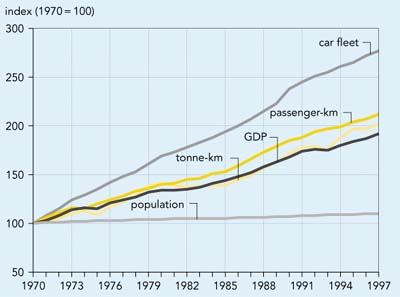|
TERM indicators
|
Objectives
|
DPSIR
|
Assessment
|
|
8. Passenger transport
|
Reduce the link between economic growth and passenger transport
demand
|
D
|

|
|
Increase shares of public transport, rail, walking, cycling
|
D
|

|
|
9. Freight transport
|
Reduce the link between economic growth and freight transport demand
|
D
|

|
|
Increase shares of rail, inland waterways, short-sea shipping
|
D
|

|
 positive trend (moving towards objective)
positive trend (moving towards objective)
 some positive development (but insufficient to meet objective)
some positive development (but insufficient to meet objective)
 unfavourable trend (large distance from objective)
unfavourable trend (large distance from objective)
? quantitative data not available or insufficient
Group policy context
The dramatic growth in transport, particularly by road and air, and the
resulting environmental and congestion problems, emphasise the need to
focus policies on transport demand management and on promoting less environmentally
damaging modes like walking, cycling, public transport, rail, inland waterways
and sea transport. This requires combined action in various policy areas,
such as spatial and transport planning (Group 3); transport infrastructure
and services supply (Group 4); pricing (Group 5); organisation of transport
operation services and freight logistics, training and education (Group
7).
The main elements of the current CTP are to improve and extend the trans-European
transport network (TEN), establish a fairer and more efficient pricing
system, revitalise the community’s railways (especially to enhance the
use of railways for freight transport) and promote intermodal and combined
transport and public transport. As yet none of these strategies aims to
reduce the overall growth in demand, nor are concrete targets set for
modal shares. The recent Commission Communication on the future development
of the CTP stated, however, that ‘the Commission will give particular
attention to measures designed to reduce the dependence of economic growth
on increases in transport activity’ (CEC, 1998b). Transport demand-management
policies are emerging only slowly in some countries.
Group key findings
- Over the past 25 years the globalisation of economies, the Single
Market and increases in welfare have led to a considerable increase
in demand for transport. Passenger and freight transport demand have
more than doubled, and both have grown more rapidly than GDP. Transport
demand in the EU in 1997 reached 5 100 bn passenger-km and 2 700 bn
tonne-km. There has been a dramatic shift towards road transport and
aviation.
- Passenger transport has grown with economic activity and ever-increasing
car ownership levels. This in turn has influenced human settlement and
socio-economic patterns. Passenger transport demand has increased much
more rapidly than population over the past 25 years, reflecting a rise
in mobility: the average daily distance travelled by EU citizens was
16.5 km in 1970 and 36 km in 1996. The spatial spread of economic activities,
urban sprawl, the evolving services sector, higher disposable income
and car ownership, and increased leisure time all influence mobility.
- Freight transport has also grown during the past decade, both internally
in the EU and for external trade. Between 1970 and 1997, with the internationalisation
of trade, freight tonne-km grew more rapidly than tonnage as journey
lengths increased. Trucking (responsible for nearly 50 %
of all EU haulage in 1997) is predicted to shift towards higher value
goods, smaller shipment sizes, higher frequency, and larger geographical
coverage which will increase journey lengths and decrease average loads
still further. While the Community’s freight transport action plans
have resulted in a better performance of short-sea shipping (shipping
accounted for some 40 % of EU freight transport in 1997), they
have not yet reversed the declining shares of rail and inland waterways.
Figure 2.1: Growth in population, economic activity and transport
demand (EU)

Source: DG Transport, Eurostat
|

Document Actions
Share with others